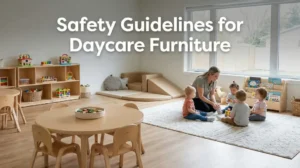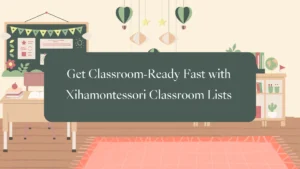Are you looking for creative and practical daycare classroom decoration ideas? Daycare classroom decoration ideas can improve your classroom environment and give children a friendly and stimulating place to grow up. However, not all decorations are good, and too many unnecessary decorations can make the daycare classroom noisy and distracting for the children.
Daycare classroom decoration ideas are about creating a nurturing, stimulating environment that supports various activities and learning styles. It requires a careful selection of colors, furnishings, and educational materials that are age-appropriate and conducive to learning and growth. The goal is to create a space where children are excited to explore, learn and grow.
As educators and caregivers, daycare classroom decoration ideas should keep the interests of young learners at the forefront of your mind. Our brand understands the importance of creating a nurturing space that fosters imagination, curiosity and learning. We’ve compiled these daycare classroom decoration ideas to transform your classroom into a vibrant and educational haven.
Why Daycare Classroom Decoration Ideas Are Important?
The importance of daycare classroom decoration ideas cannot be overemphasized. Beautiful daycare classroom decoration ideas help develop cognitive skills, foster emotional well-being, and promote social interaction. Based on my 20+ years of experience in the education industry, we have found that classrooms that balance aesthetics and function provide the best learning experience. The décor of the classroom should reflect a sense of warmth and inclusivity so that children feel safe and valued. This includes choosing safe and comfortable furniture, using colors that enhance mood and attention, and incorporating elements that reflect the children’s diverse backgrounds.
Furthermore, how a classroom is decorated can greatly influence a child’s behavior and attitude toward learning. A cluttered, disorganized space can lead to distractions and restlessness, while a well-organized, engaging classroom can promote focus and eagerness to engage in activities. It’s also important to remember that the classroom environment serves as a third teacher – it can either stimulate or hinder the natural learning process of children.
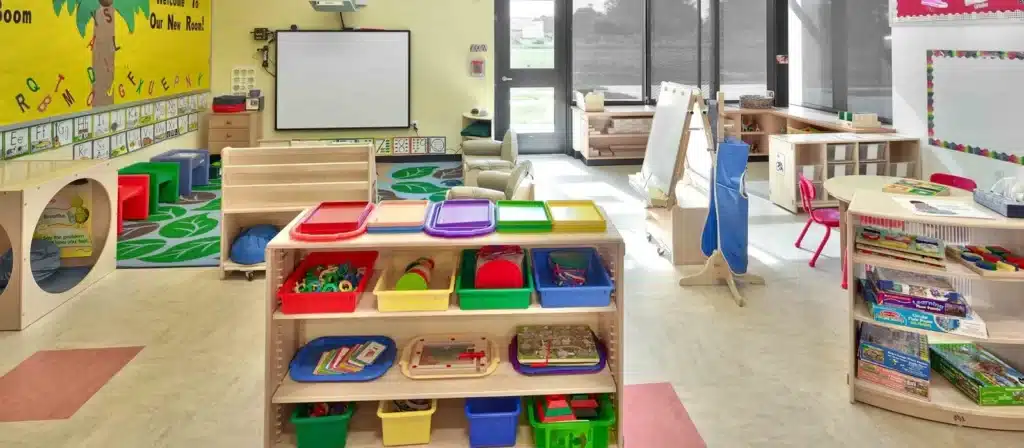
What Are the Key Elements of Daycare Classroom Decoration Ideas?
A successful daycare classroom decoration plan involves more than bright colors and fun shapes. It’s a thoughtful combination of visual design, educational value, emotional comfort, and practical layout. Each element contributes to a cohesive environment where children feel safe, stimulated, and ready to explore.
1. Daycare Classroom Decoration Ideas: Safety First
Safety is paramount in a daycare setting. All furniture and decorations should be designed with children’s safety in mind. This means no sharp edges, small parts, or hazardous materials. Additionally, ensure that all daycare furniture is sturdy and secured to prevent tipping.
2. Daycare Classroom Decoration Ideas: Color
Color can affect mood, energy levels, and even cognitive function. In a daycare classroom, choosing soothing and stimulating colors is crucial. For example, blue is known for its calming effect and can be used in areas designated for rest or quiet activities. On the other hand, yellow is bright and vibrant, making it perfect for play areas or creative corners.
Red is another stimulating color, but should be used cautiously as it can appear in large quantities. Green is considered the most calming color for the eyes and can create a sense of balance and serenity in the classroom. It is perfect for areas where concentration is needed, such as reading or puzzle corners.
When incorporating color into a daycare classroom, it’s also important to consider color combinations. Harmonious color schemes can create a visually appealing environment that enhances the learning experience. However, avoiding overly bright or contrasting colors is important as they can distract and overstimulate young children.
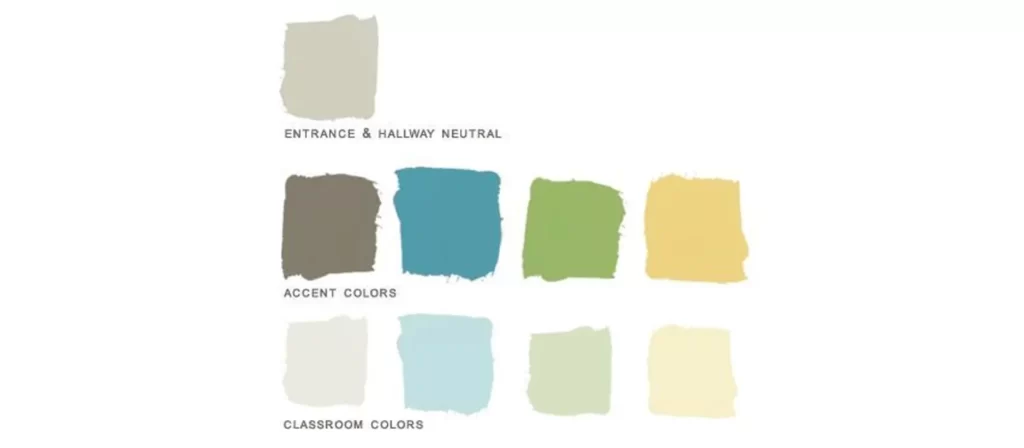
3. Daycare Classroom Decoration Ideas: Furniture
The right classroom furniture is the backbone of any daycare classroom. It should be inviting, durable, and appropriate for the age group you’re catering to.
- Safety and Comfort
All daycare furniture must be safe for children. Rounded edges, stable construction and non-toxic materials are a must. Comfort is also key. Children are more likely to engage and learn when they are sitting comfortably. This means adjustable chairs and tables are very beneficial. - Functionality and Flexibility
Consider furniture that serves multiple purposes. For example, tables with built-in storage can be used for activities and organization. Flexibility is also important. Furniture that can be easily moved or reconfigured allows the classroom to adapt to different activities and learning styles. - Aesthetic Appeal
Bright colors and playful designs can stimulate young minds and make the learning environment more enjoyable. - Multi-functionality and Storage
In a daycare classroom, space may be limited. Choose versatile furniture for daycare classroom decoration, such as tables with built-in storage or stackable chairs. Efficient storage solutions are essential for organizing supplies and keeping the classroom tidy.
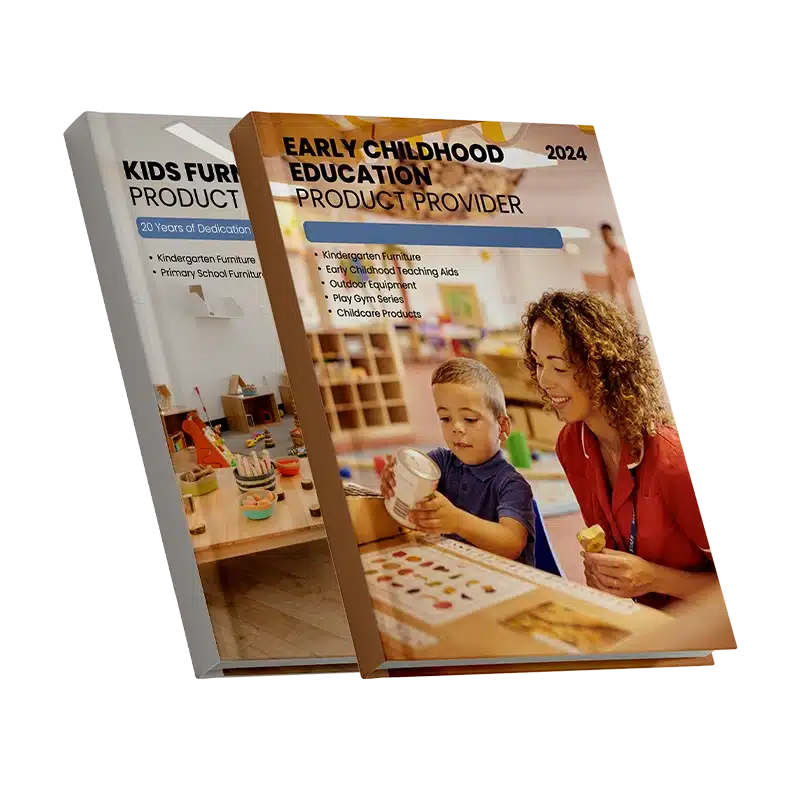
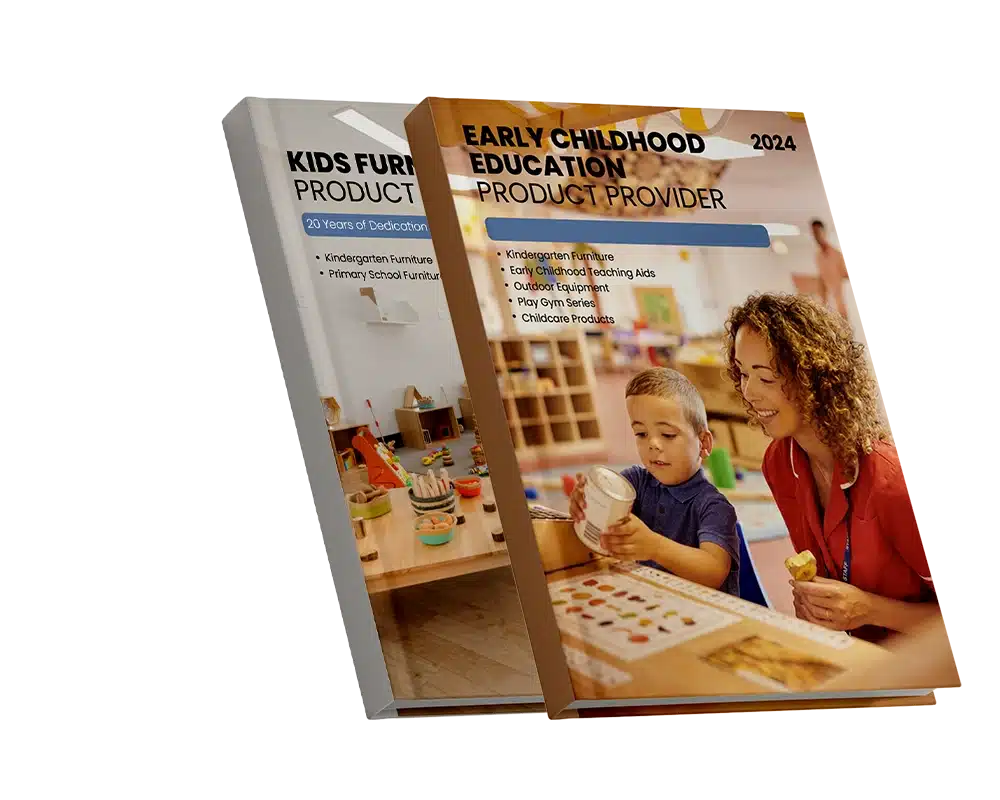
4. Daycare Classroom Decoration Ideas: Classroom Layout
The layout of a daycare classroom impacts the flow of activities and the overall learning experience. A well-planned layout facilitates movement, minimizes distractions, and provides areas for different activities.
- Zoning for Activities
Create distinct zones for reading, arts and crafts, and quiet play. This helps organize the classroom and aids children in understanding and adhering to the classroom’s routines. - Accessibility and Movement
Ensure that the classroom layout allows for easy movement and accessibility. Children should be able to move freely between different areas without obstructions. This is crucial for their physical development and for fostering independence. - Visibility and Supervision
Arrange the classroom so that every area is visible to the teacher. This ensures that children are always supervised, contributing to a safer environment.
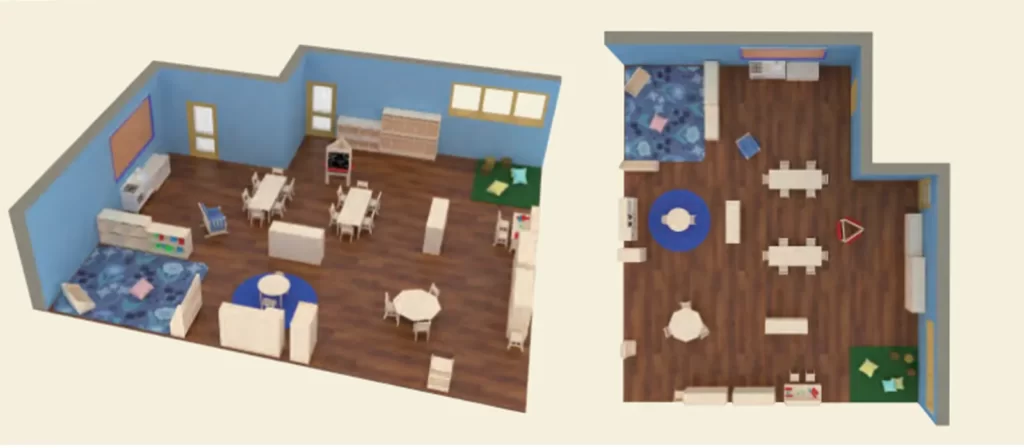
5. Daycare Classroom Decoration Ideas: Floors, Windows, and Walls
The foundation of any room décor begins with the floors, windows and walls. Daycare classroom decoration should be made with materials and designs that are safe, easy to clean, and visually stimulating.
Window Coverings and Decals:
- Blinds and Window Shades: Opt for cord-free options to ensure safety. These coverings let you control natural light levels, creating an ideal learning atmosphere.
- Decorative Touch: Use decals and other treatments to enhance aesthetics and reduce UV exposure, adding a playful element to the classroom.
Wall Decorations:
- Educational and Inspirational Posters: Classroom posters and wall decorations can incorporate classroom themes. They can include educational themes like alphabets, maps, and nature diagrams or introduce students to art.
- Art Display Wall: An essential feature in any classroom, it showcases students’ artwork, fostering pride and highlighting the class’s unique character. Some companies offer custom murals based on student art for a special touch.
Flooring:
- Rugs and Play Mats: Choose tightly woven carpets or foam play mats in solid colors to prevent small objects from becoming hazards. A low-carpeted platform can serve as a mini-stage for dramatic play.
- Non-toxic Materials: Always select non-toxic materials like lead-free paints and phthalate-free wallpapers for floor and wall coverings. Avoid overly busy patterns that can distract students.
Classroom Essentials:
- Calendar: Display a calendar prominently for tracking days and anticipating events. This aids in teaching about time and allows for personalization with stickers reflecting students’ interests.
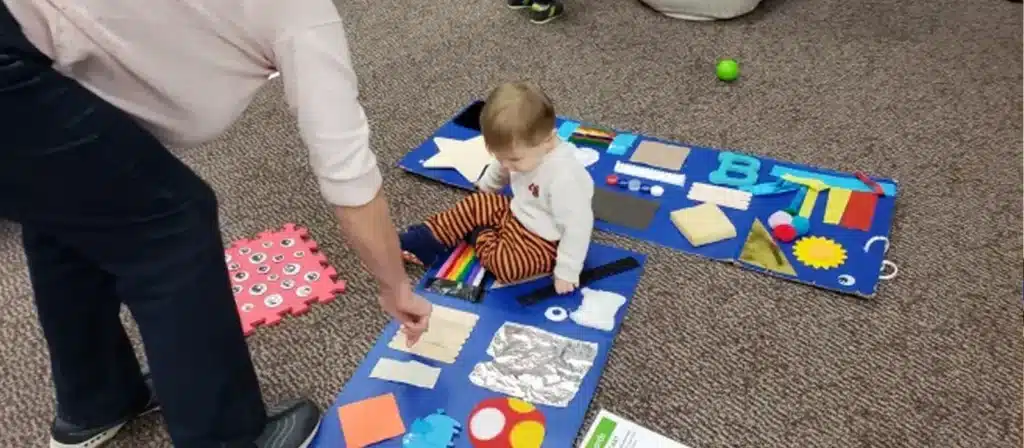
6. Daycare Classroom Decoration Ideas: Sensory Elements
Sensory elements in a daycare classroom decoration can significantly enhance the learning experience for children. These can include visual, tactile, auditory, or olfactory elements to stimulate learning and development.
- Visual Elements: Color and Patterns
Use vibrant and calming colors to create a balanced visual environment. Patterns and shapes can be used to stimulate visual learning. For example, geometric shapes or thematic patterns that change with the curriculum. - Tactile Experiences: Textures and Materials
Incorporate a variety of textures in the classroom. Rugs, cushions, and different materials for play can stimulate the sense of touch. - Auditory and Olfactory Elements
Background music or natural sounds can create a calming or stimulating atmosphere. A classroom that smells fresh and clean contributes to a pleasant and healthy learning environment.
7. Daycare Classroom Decoration Ideas: Educational Decorations
Incorporate educational elements into your decorations. This could include alphabet charts, number posters, and interactive wall displays. These decorations add visual interest and serve as learning tools to help children develop their cognitive development.
8. Daycare Classroom Decoration Ideas: Interactive Spaces
Create interactive spaces where children can engage in hands-on activities. This could include art corners, science stations, and sensory play areas. These spaces encourage creativity, exploration, and critical thinking.
9. Daycare Classroom Decoration Ideas: Natural elements
Incorporating natural elements into daycare classroom decoration benefits children’s development. Adding natural elements such as plants and sunlight can create a calm and welcoming atmosphere for children. Natural light can also improve a child’s mood and energy levels. Nature-themed decorations and small indoor gardens where children can learn to care for plants and reduce stress. It also provides opportunities for hands-on learning about biology, ecology and responsibility.
Daycare Classroom Decoration Ideas by Age Group
Designing a daycare classroom takes careful consideration of the children you serve and their needs based on their age. The classroom Decoration and daycare furniture you use should be practical, developmentally appropriate, and promote various activities and learning.
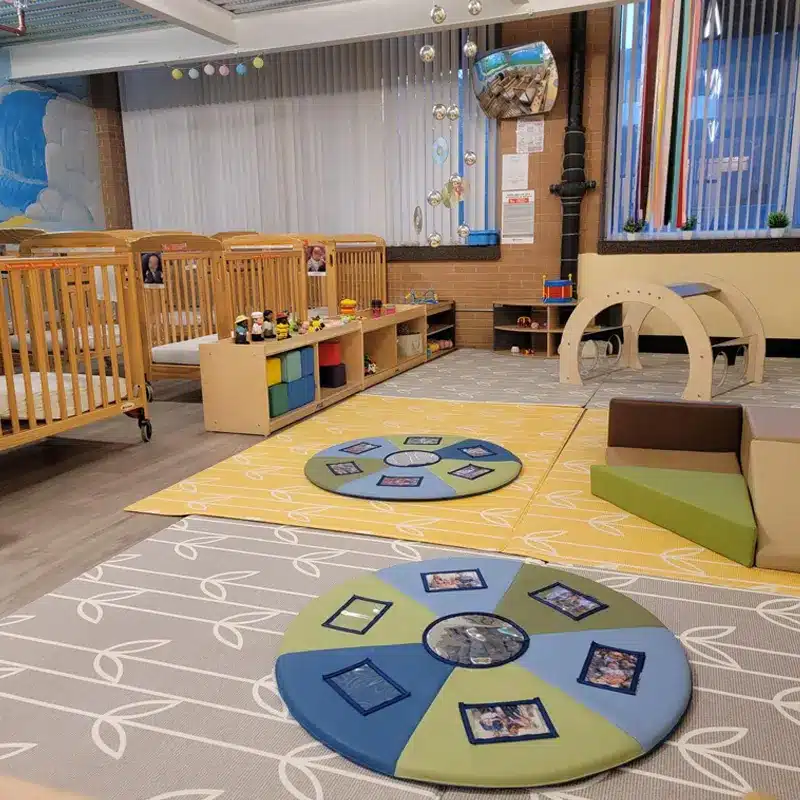
Ideas for Infant Rooms (0–12 Months):
For infants, focus on bright, primary colors and simple shapes to stimulate sensory development. Include tactile elements like soft fabrics and foam puzzles they can touch and explore. Soft colors like pastels and warm neutrals help reduce overstimulation and promote rest. Because babies are often lying on their backs or being held, consider ceiling decorations—like gentle mobiles or fabric canopies—that move slowly and catch their attention.
Mirrors at floor level encourage self-recognition, while black-and-white contrast patterns help stimulate early vision development. Wall displays should be minimal but meaningful—such as family photo boards or large images of animals, faces, and simple shapes. Texture is another key element; soft wall hangings or tactile panels give infants safe surfaces to touch and explore.
Ideas for Toddler Rooms (1–2 Years):
Toddlers are on the move, curious about everything, and learning to express themselves. Bright colors, bold patterns, and interactive elements are perfect for this age. Incorporate more complex educational elements. This can include alphabet and number displays, simple maps, and nature elements. Include interactive elements like dress-up corners or mini science labs to encourage exploration and imaginative play.

Create themed corners with visuals that represent objects toddlers are learning to name, such as fruit, vehicles, or pets. Sensory walls with textures, peek-a-boo flaps, and movable parts keep them engaged. Also, consider using large labels with images on shelves and bins to teach object recognition and help toddlers participate in tidying up.
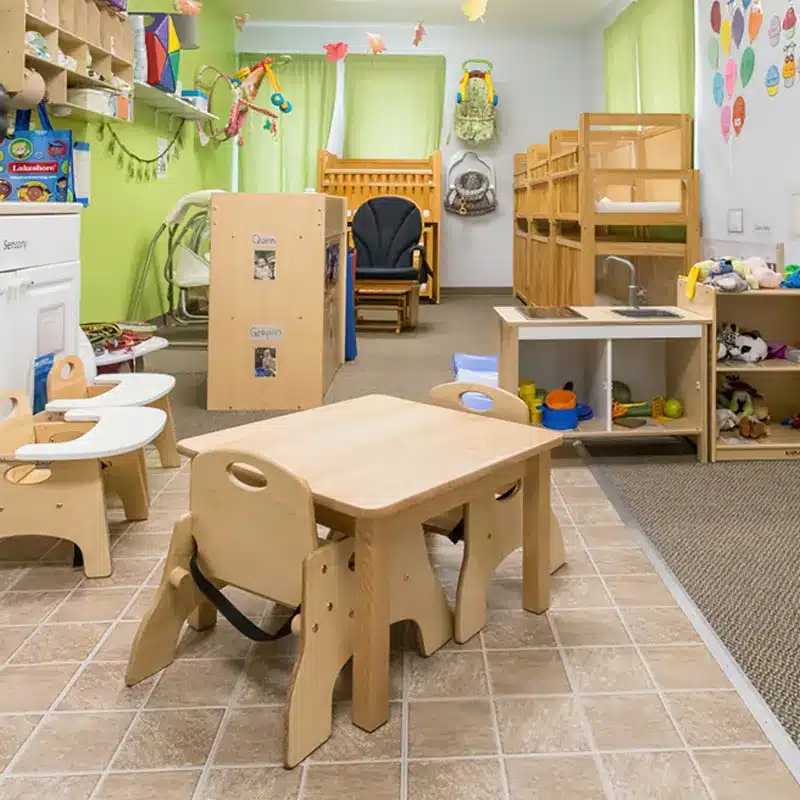
Ideas for Preschool Rooms (2-3 years old):
Preschoolers are developing early literacy and social-emotional skills, so decorations should stimulate imagination, learning, and cooperative play. Alphabet and number charts, daily routine boards, and classroom job charts support structure and academic growth.create areas that foster independent learning and group activities. Include reading nooks, art stations, and areas for science and math activities. Decor should be more sophisticated, with real-world educational materials like globes, time zone maps, and historical timelines.
Thematic wall displays based on seasons, holidays, or curriculum topics—like dinosaurs, space, or community helpers—make learning fun and relevant. A “word wall” or interactive bulletin board where children can match letters and objects encourages early reading. Include plenty of child-made artwork in the décor to promote confidence and creativity.
Theme-Based Daycare Classroom Decoration Ideas
Decorating a daycare classroom with a thoughtful theme not only makes the environment visually appealing but also sparks imagination and supports early learning. A themed approach helps create consistency, reinforces educational concepts, and builds excitement among children. When done well, daycare classroom decoration reflects both functionality and fun, aligning with developmental goals while keeping the space playful and engaging.
Why Use a Theme in Daycare Classroom Decoration?
Themes help children make connections between visuals and what they’re learning. A nature theme, for instance, can tie into lessons about animals, plants, or the weather, reinforcing vocabulary and comprehension through visual aids and props. Plus, themed decorations provide a structured way to rotate learning centers and seasonal displays, keeping the classroom fresh and stimulating.
Popular Daycare Classroom Themes and Ideas
- Under the Sea: Incorporate ocean colors like blues and teals. Use hanging jellyfish made of streamers, fish cutouts on the walls, and a reading nook styled like a boat. This theme is excellent for teaching about marine life and water safety.
- Jungle Safari: Use leafy greens and animal prints. Add plush animals, DIY vines, and animal tracks on the floor. This is great for lessons on habitats, animal sounds, and geography.
- Space Adventure: Black walls with glow-in-the-dark stars, spaceship crafts, and planets hanging from the ceiling can ignite curiosity about the universe. Include rocket ship-shaped seating or reading pods.
- Seasonal Themes: Rotate your decorations with the seasons. For fall, use leaves, pumpkins, and scarecrows. In spring, focus on flowers, butterflies, and rainbows. This keeps your decor dynamic and educational.
- Alphabet Garden: Combine literacy with nature. Each letter is a “plant” growing from the ground with associated objects (A for apple, B for bee). This helps preschoolers connect letters with familiar items.
- Community Helpers: Decorate different areas to represent a fire station, hospital, or grocery store. Include dress-up areas to encourage role-play. This builds social awareness and respect for different professions.
Tips for Theme-Based Decoration Success
- Keep it Safe and Accessible: Ensure all decorations are non-toxic, securely fastened, and placed within children’s eye level to foster interaction.
- Involve the Kids: Let children contribute to decorating. Their art projects or themed crafts can become part of the display.
- Use Multi-Sensory Elements: Include textures, lights, music, and interactive features that align with the theme. This supports sensory development.
- Rotate Themes Periodically: Changing themes keeps the environment engaging and gives you opportunities to introduce new topics.
How to Maintain a Decorated Daycare Classroom?
Maintaining a beautifully decorated daycare classroom goes beyond aesthetics—it ensures the space remains functional, safe, and stimulating throughout the year. While it’s tempting to focus solely on the fun of decorating, consistent upkeep plays a critical role in sustaining a positive learning environment for young children.
Prioritize Cleanliness and Safety
A major part of daycare classroom decoration maintenance is ensuring that all items are clean and securely installed. Children interact closely with their surroundings, which means walls, displays, and decor elements need to be hygienic and hazard-free.
- Regular Cleaning: Wipe down surfaces, especially high-touch decorations like sensory boards or felt walls, with child-safe disinfectants.
- Check for Wear and Tear: Inspect decorations weekly for loose staples, peeling materials, or broken parts. Replace or repair as needed to avoid potential safety risks.
- Use Durable Materials: Laminate posters, opt for tear-resistant paper, and use velcro instead of pins for student work—these adjustments prolong decor life.
Change Decorations Throughout the Year
Changing decorations throughout the year keeps the environment fresh and engaging for children. Seasonal themes can be a fun way to do this. Decorate with autumn leaves and pumpkins in the fall, snowflakes and winter scenes in the winter, flowers and rainbows in the spring, and sun and beach themes in the summer.
Halloween, Christmas, and Easter decorations can also add excitement and variation. Additionally, themes related to what children are learning should be considered. If the focus is on animals, a jungle theme could be exciting. If they are learning about space, transform the room into a mini galaxy.
Involve Children in Maintenance
Involve the children in the decorating and maintenance process. This could include having them help with cleaning, organizing, and updating decorations. It teaches them responsibility and gives them a sense of ownership in their classroom.
- Classroom Jobs: Assign small, age-appropriate roles like “wall helper” or “poster straightener.”
- Ownership Through Art: Replace wall art frequently with student-created projects to keep the room feeling personalized and dynamic.
Use Practical Storage Solutions
Smart storage is the backbone of an organized daycare classroom. Without it, even the most beautifully decorated space can quickly become chaotic. Clear, labeled bins—especially those with picture-word labels—make it easy for kids to find and return items, reinforcing independence and responsibility.
Use shelves at child-height to store toys and materials, so kids can access them safely and confidently. Wall-mounted pockets, baskets, and hooks are excellent for utilizing vertical space and keeping floors free for movement. Assign specific areas for different types of supplies to streamline cleanup and minimize clutter.
Balance Between Decoration and Functionality
Maintaining the balance between decoration and functionality in a daycare classroom requires regular assessment and adjustments. Over time, decorations can accumulate and unintentionally take over useful wall or table space, making the environment feel crowded or chaotic. To avoid this, conduct periodic walk-throughs to evaluate whether each decorative item still serves a clear purpose or if it has become visual noise.
Also, be sure to update or remove decorations that no longer align with the current curriculum or season. Keeping displays relevant ensures that children remain engaged and that the decor continues to support their daily learning activities. If a wall display hasn’t been interacted with in weeks, it may be time to refresh it.
Decorating Daycare Classroom Activity Areas
The daycare classroom has specialized areas to meet various developmental needs and activities. Classroom décor also needs to be adapted to the different areas. These include check-in/check-out areas, cubicle storage areas, quiet activity areas, open activity areas, messy activity areas, and age-specific areas. Each of these areas provides unique opportunities for learning and growth, ensuring that each child’s developmental needs are met in a well-rounded, engaging and safe daycare classroom.
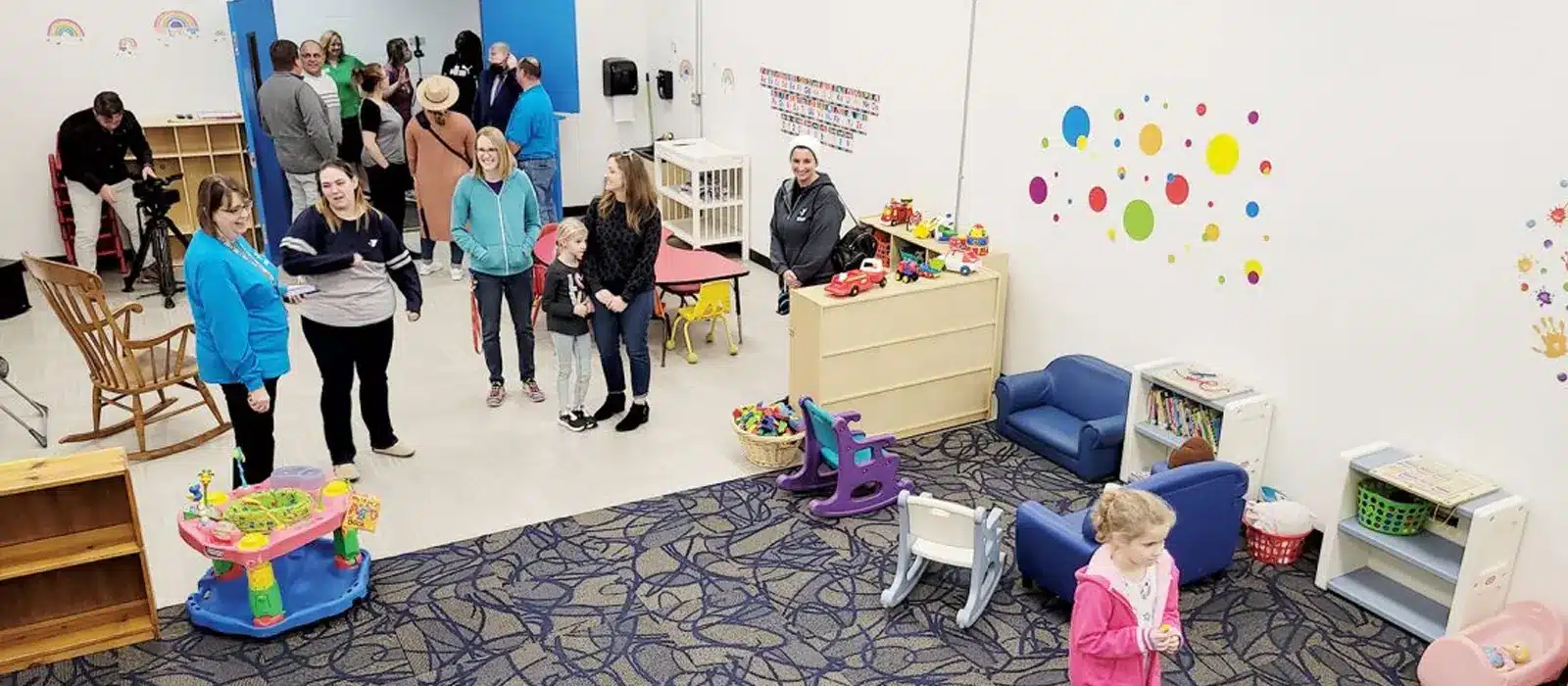
Check-in/Check-out Areas
The Check-in/Check-out Areas is the gateway to the day’s adventures in a childcare classroom. This area is crucial for establishing a routine, a sense of belonging, and security among the children.
This area sets the tone for each child’s day and should feel warm, cheerful, and organized. Thoughtful decor here eases transitions and gives parents a welcoming space during drop-off and pick-up.
- Use a “Welcome” sign with children’s names or photos
- Display a daily visual schedule near the entrance
- Add a family photo wall for emotional comfort
- Include parent info boards with notices and classroom news
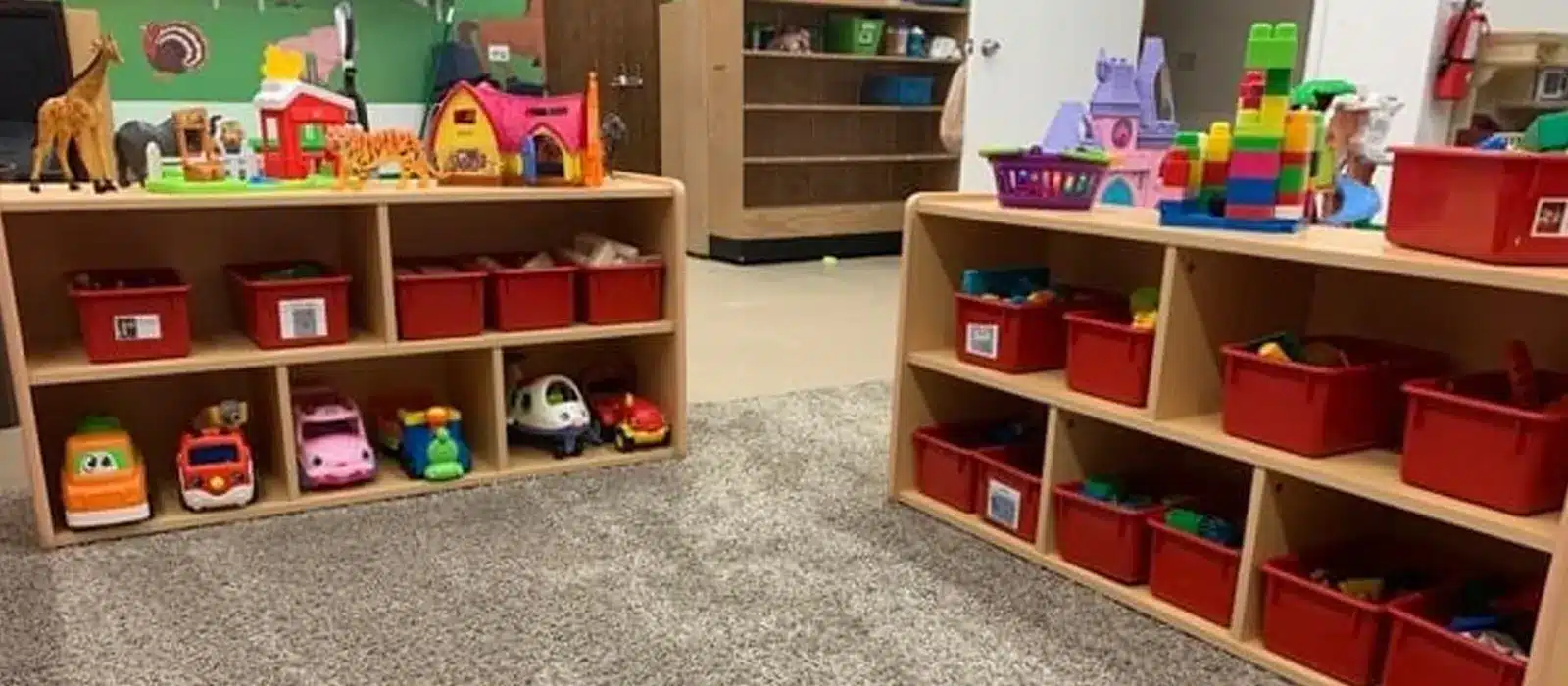
Cubby Storage Areas
The Cubby Storage Areas is more than just a place to store jackets and backpacks. It’s a personal space for each child within the classroom, serving several important functions:
Though often overlooked, cubbies offer a great chance to add color, organization, and personality. Personalized decorations help children identify their space and feel a sense of ownership.
- Decorate each cubby with name tags and child photos
- Use symbols or icons for non-readers
- Add colorful borders or mini seasonal accents
- Label bins or baskets with matching visuals
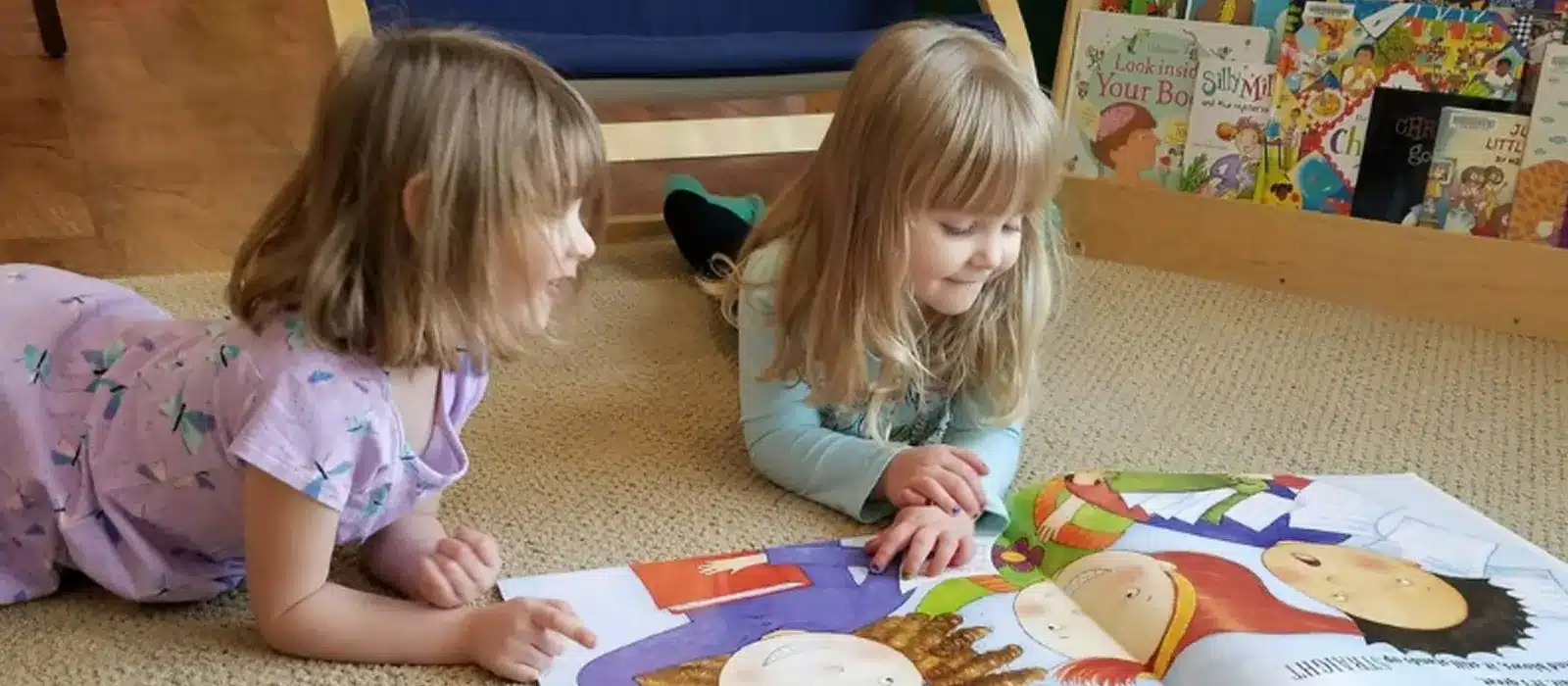
Quiet Activity Areas
In the Quiet Activity Areas, tranquility and focused learning take center stage. This area is essential for activities that require concentration and calm:
A calm atmosphere in quiet areas encourages focus, reading, and emotional regulation. Keep decor soft and simple while adding cozy, visually soothing elements.
- Use soft lighting or fairy lights
- Hang calming posters with nature or sky themes
- Add floor pillows, rugs, and canopies
- Include visual aids for emotions or breathing exercises
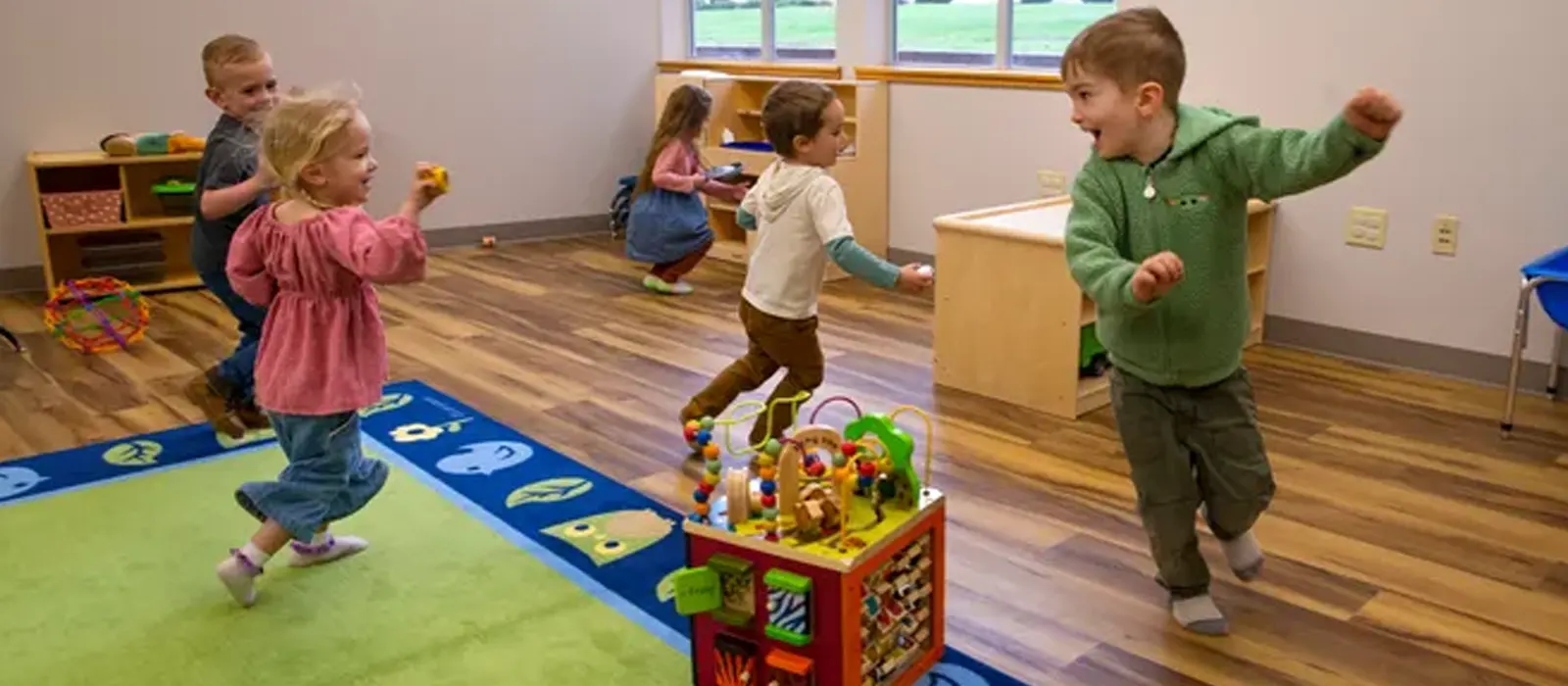
Open Activity Areas
The Open Activity Areas is the heart of collaborative and unrestricted play. It’s designed to foster social skills, creativity, and physical development:
This is where children play, move, and imagine freely—so the decor should be lively and theme-driven. Keep it open and flexible, but visually exciting.
- Use hanging decorations like stars, leaves, or animals
- Add wall murals or theme-based banners
- Apply vinyl floor stickers for play or movement guidance
- Rotate theme props and visuals monthly
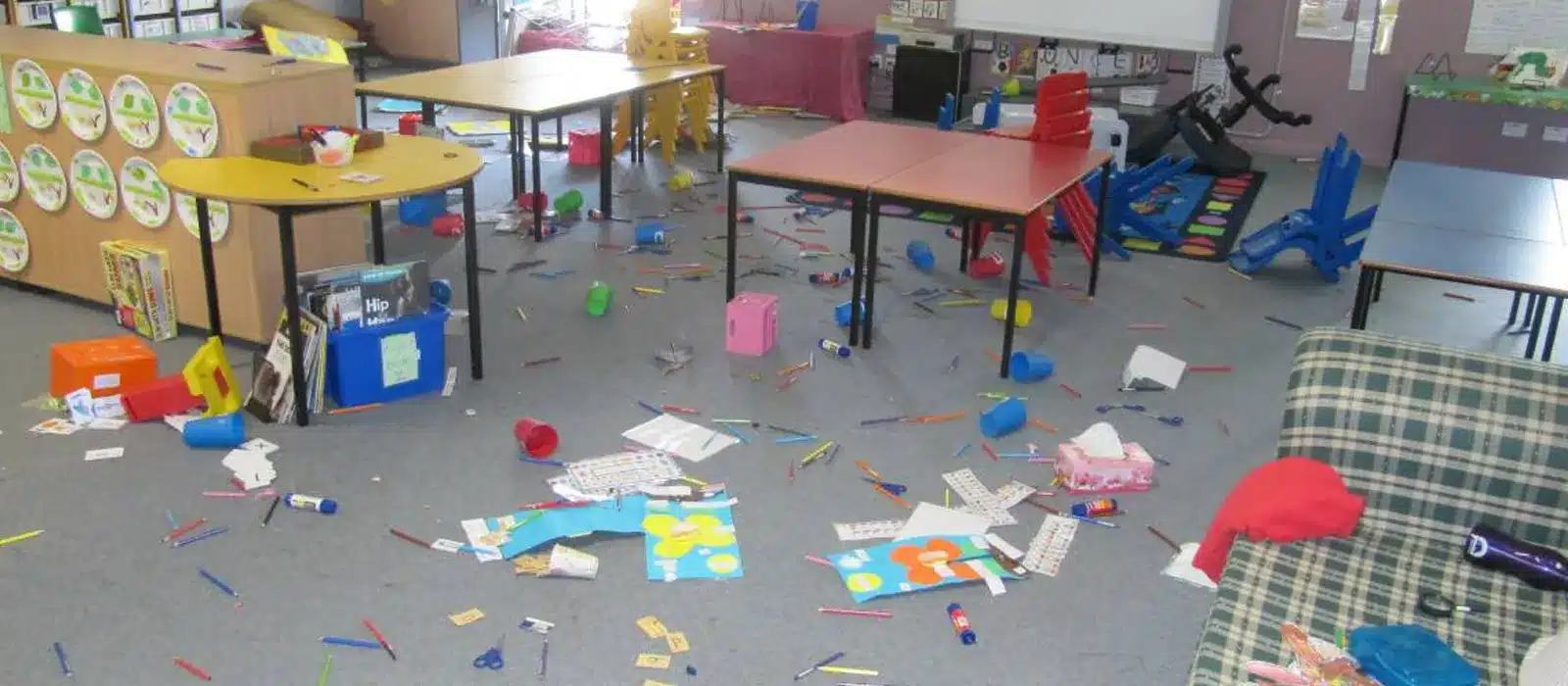
Messy Activity Areas
The Messy Activity Areas embraces the chaos and creativity that come with childhood exploration. It’s a space dedicated to activities that are, by nature, messy but incredibly beneficial for development.
Art and sensory play thrive in bold, colorful spaces. Decorations here should celebrate creativity while being easy to clean and update.
- Use bright wall art like splatter paint or color wheels
- Display drying racks or clipboards for children’s art
- Add clear cleanup instruction visuals
- Protect walls with laminated or washable materials

Age-Specific Areas
Age-Specific Areas are tailored to meet the developmental needs of different age groups within the childcare setting:
Decor should match developmental stages, ensuring visuals and interactivity are both appropriate and engaging for each age group.
- Infants: High-contrast visuals, mirrors, and mobiles
- Toddlers: Bold images, simple labels, sensory boards
- Preschoolers: Alphabet charts, science corners, themed bulletin boards
- Always place decor at child’s eye level for accessibility
Incorporating Montessori Principles into Daycare Classroom Decor
- Child-Centered Design: Montessori classrooms are designed to be child-centered, meaning that everything is at the child’s level and accessible to them. This includes low shelves, child-sized furniture, and materials that children can use independently.
- Natural Materials: Natural materials such as wood, cotton, and wool are used for decorations and furniture. These materials are more aesthetically pleasing, durable, and sustainable.
- Minimalist Approach: Montessori environments are typically minimalist, emphasizing simplicity and order. Avoid clutter and unnecessary decorations. Instead, choose a few key pieces that serve aesthetic and educational purposes.
- Hands-On Learning: Incorporate materials and activities that promote hands-on learning. This could include puzzles, building blocks, and other manipulatives that children can use to explore and learn.
The Significance of Wall Art in Daycare Classrooms
In addition to decorating the walls, wall art in daycare centers is a medium for children to learn, explore and express themselves. Wall art can include educational posters, inspirational quotes, children’s artwork, or murals reflecting nature, stories, or multiculturalism.
The presence of wall art makes an environment more vibrant and attractive, stimulating children’s visual senses. It can serve as a conversation starter, stimulating curiosity and encouraging questions.
In addition, wall art can be used as an educational tool. For example, posters of letters or numbers can help teach basic literacy and numeracy skills. Maps, scientific charts or historical timelines can provide visual aids for more complex concepts.
Impact of Wall Art on Children’s Development
Wall art significantly impacts children’s cognitive, emotional, and social development. Engaging with visually stimulating environments can enhance learning and memory retention for young children. Colors, shapes, and patterns found in wall art can aid in developing visual discrimination skills.
Emotionally, wall art can create a welcoming and comforting environment, helping children feel more secure and at ease in the daycare setting. It can also be a form of expression, allowing children to see their creations displayed, which builds self-esteem and a sense of accomplishment.
Socially, wall art can encourage interaction and collaboration among children. Group projects like mural painting or collage creation foster teamwork and communication skills. Moreover, inclusive and diverse wall art can promote cultural awareness and sensitivity from a young age.
What Other Supplies Do I Need When Starting a Daycare Classroom?
When opening a daycare center, in addition to decorating the classroom, you’ll need a range of supplies to ensure a functional and safe environment. This includes child-sized furniture such as tables, chairs and storage units. In addition, consider restocking supplies such as art materials, educational toys, books and games that are integral to your child’s learning and play.
Essential safety equipment, including first aid kits, fire extinguishers and childproofing. Make sure all areas are free of hazards and comply with safety regulations.
Invest in practical items such as nap mats or cribs, feeding utensils, and hygiene items like hand sanitizer and paper towels. Technology like computers or tablets are valuable for educational purposes, but their use should be carefully managed.



Where Can I Find Daycare Classroom Decorations?
Finding the right decorations for a daycare center can be challenging. Start by visiting online and brick-and-mortar educational supply stores, which often have special classroom decor sections. These stores typically offer various products, from wall decals and educational posters to age-appropriate furniture and play area equipment.
Online marketplaces such as Amazon and Alibaba also offer many options for daycare decor. Here, you can find unique items from a variety of sellers around the world. However, make sure the products meet safety standards and are appropriate for the age group of your daycare.
You can find professional daycare classroom furniture manufacturer and suppliers online. Xiha Montessori offers you the best selection of daycare furniture. We have more than 20 years of experience in the education industry, and we not only help you provide competitive products but also help you provide educational methods, providing one-stop service from classroom layout design and furniture customization to shipping and delivery for more than 2,000 educational institutions around the world!
Consultation With Professionals
Consulting with educational experts, including early childhood educators, child psychologists, and interior designers specializing in educational spaces, can provide valuable insights into effective classroom decoration. These experts can provide insight into the latest trends in daycare classroom decoration and design regarding age-appropriate decor and color psychology and create an inclusive environment that caters to children with different learning needs and cultural backgrounds.
Hosting workshops or Q&A sessions with these experts can benefit staff and parents. This helps with daycare classroom decoration and ensures the decor meets educational goals and child development theories.
Optimize Your Daycare Operations with Xiha Montessori Solutions
At Xiha Montessori, we offer comprehensive solutions to optimize your daycare classroom. Our products include high-quality furniture, decor, and educational materials tailored to various developmental stages. We understand the unique needs of daycare centers and provide customizable options to fit your requirements.
Our services extend beyond products. We offer consultation on classroom layout, decoration ideas, and resource management to maximize the effectiveness of your child care environment. Our team of experts stays updated on the latest educational trends and safety standards, ensuring our solutions are innovative and compliant.
Partnering with Xiha Montessori means you’re not just purchasing products but investing in a holistic approach to child care that emphasizes quality, safety, and educational value. Our commitment is to support you in creating a nurturing, stimulating, and efficient daycare environment.
FAQs About Daycare Classroom Decoration
- How often should I change daycare classroom decorations?
Ideally, decorations should be updated seasonally or monthly to keep the classroom fresh and relevant. However, smaller updates like rotating student artwork or changing bulletin board content can be done more frequently. - How can I decorate a daycare classroom on a budget?
Use recycled materials, printable wall art, and DIY crafts. Involve children in creating decorations to save costs and make the space more personal. Thrift stores and dollar shops also offer affordable supplies. - Should daycare classroom decorations be educational or just fun?
Ideally, they should be both. Decorations that are visually appealing and incorporate learning—like number lines, ABC walls, or themed vocabulary—can reinforce curriculum objectives while making the space enjoyable. - Is it necessary to include student artwork in classroom decor?
Yes! Displaying children’s artwork builds self-esteem, gives them ownership of the space, and reflects their development. Rotate pieces regularly to keep the environment dynamic and inclusive. - What themes are best for daycare classroom decoration?
Popular themes include seasons, animals, alphabet and numbers, multicultural celebrations, and community helpers. Themes should be age-appropriate and support the educational goals of the classroom. - Should daycare classroom decorations be different for infants and toddlers?
Yes. Infants benefit from high-contrast visuals and simple, soothing colors, while toddlers enjoy more interactive and colorful displays. Always match decorations to developmental stages.
Conclusion
Decorating a daycare classroom is a thoughtful process that involves considering children’s developmental needs, the space’s functionality, and the curriculum’s educational goals. We can create a stimulating and comforting environment by focusing on age-appropriate decor, changing themes throughout the year, seeking expert advice, and tailoring room setups for different age groups. At Xiha Montessori, we are dedicated to providing resources and products that support this important work.



